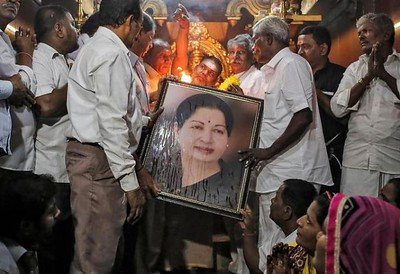Read in : தமிழ்
Though born in a brahmin family, Jayalalithaa grew to become arguably the most popular Dravidian party leader. The irony could not have been missed on her birthday.
Putting behind it the recent civic election reverses and loss of power last year, the AIADMK on Thursday (Feb. 24, 2022) stuck to the protocol, paying homage to its erstwhile supremo J Jayalalithaa (Feb 24, 1948-Dec.5, 2016).
A typical party worker cannot help but wish how 2022 would have been celebrated on an unprecedented scale as their Amma’s 75th birthyear and the party’s golden jubilee year coinciding with the country’s 75th Independence Day, had she been alive and continued to be in power.
Born six months after Independence, unlike her political rival and DMK patriarch M Karunanidhi who was 23 then, she straddled Karnataka and Tamil Nadu till the 1960s when she became the darling of the masses after pairing with charismatic actor M G Ramachandran. The 60s and the 70s saw her calling the shots in the tinsel world. Her last film in 1980 ‘Nadhiyai Thedivantha Kadal’ (sea in search of river) symbolically presaged her future, the sea of politics beckoning the river that she was.
The 80s saw her learning the ropes of politics with all its rivalries and cruelties under the tutelage of her mentor MGR. After the demise of her godfather, the onus of steering the party fell on her shoulders. She came out of the ordeal of a split in the party thanks to the withdrawal from the race of her mentor’s wife V N Janaki who donned the CM’s robes briefly.
Her last film in 1980 ‘Nadhiyai Thedivantha Kadal’ (sea in search of river) symbolically presaged her future, the sea of politics beckoning the river that she was.
The humiliation she suffered at the hands of her own partymen at MGR’s funeral on Dec 25, 1987, the attack that allegedly came from some members of the then ruling party led by Karunanidhi in the Assembly on March 25, 1989, and a road accident in February, 1990 that led her to be hospitalized had probably steeled her resolve to storm the male bastion and beard the lions in their own den.
Regarding what she called the Assembly attack, Jayalalithaa herself said, “They all concentrated on me and directed blows on my head. They were throwing the podium, the bell on the Speaker’s table, big pads and bundles of budget papers, books and whatever missiles they could lay their hands on. I felt giddy and almost fainted. When party MLAs tried to escort me out, a DMK Minister caught hold of my saree and pulled it. This resulted in the safety pin on the shoulder giving way causing bleeding injuries. The saree was torn” (The Hindu).
Just like the pictures of MGR in hospital worked electoral wonders for the DMK in 1967 and for the AIADMK in 1984, the pictures of the 41-year-old Jayalalithaa coming out of the Assembly, hair dishevelled, distraught expression on the face and saree torn tilted the tide in favour of her party in the 1991 elections.
Most women sympathized with her in what was a case of gender affinity. This writer still remembers a day during the 1991 elections when a village woman angrily told me, “How dare these menfolk touch the saree of a woman? Till now I have voted for the DMK. Now I will cast my vote for ‘Amma.’
The emergence of Jayalalithaa as an unavoidable leader in the Dravidian movement was quite strange and surprising. The movement had basically originated in the concept of anti-brahminism. It was to counter the dominance of brahmins in all fields including the government, that the South Indian Liberal Federation (Thenninthiya Nala Urimai Sangam – South Indian Welfare Right Association) was formed in 1917. The outfit born as a sequel to several anti-Brahmin conferences was the mother of all Dravidian parties that emerged later – Justice Party, Dravidar Kazhagam, Dravida Munnetra Kazhagam, All India Anna Dravida Munnetra Kazhagam and so on.
The Dravidian movement has seen several stalwarts such as Natesan Mudaliar, Pitty Theogaraya Chetty, PT Rajan (grandfather of today’s Finance Minister), TM Nair, Periyar, Annadurai, Karunanidhi, MGR and so on. It is quite an irony that a brahmin woman donned the robes of a leader to head a branch of the Dravidian movement. More so, when Veeramani, the DK leader, once conferred on Jayalalithaa the title of ‘social justice warrior’.
Even K Veeramani, the DK leader, once conferred on Jayalalithaa the title of ‘social justice warrior’.
Yet Jayalalithaa seemed to have come to terms with the spirit of the Dravidian movement tenets, never playing her caste card and always swimming with the Dravidian ethos. For instance, in the infamous Kanchi Mutt Sankarraman murder case, she did not show any partiality in treating the mutt head. On the reservation issue, she did not compromise on Dravidian ideals.
All this showed her political maturity. She had molded herself into a typical Dravidian movement leader befitting Tamil Nadu.
Books such as “Ammu Muthal Amma Varai” (2009: J Ramki), “The Lone Empress: A Portrait of Jayalalithaa: (2019: Vaasanthi), and the film ‘Thalaivi’ may help posterity understand the sphinx-like personality of Jayalalithaa who cast a spell on Tamil Nadu politics for a quarter century.
Despite all the charges and cases slapped against her and despite her perceived arrogance, dictatorial nature and haughtiness, Jayalalithaa as a woman Dravidian leader who stood her ground is more remembered by the masses as MGR’s heir than his wife VN Janaki.
Read in : தமிழ்











